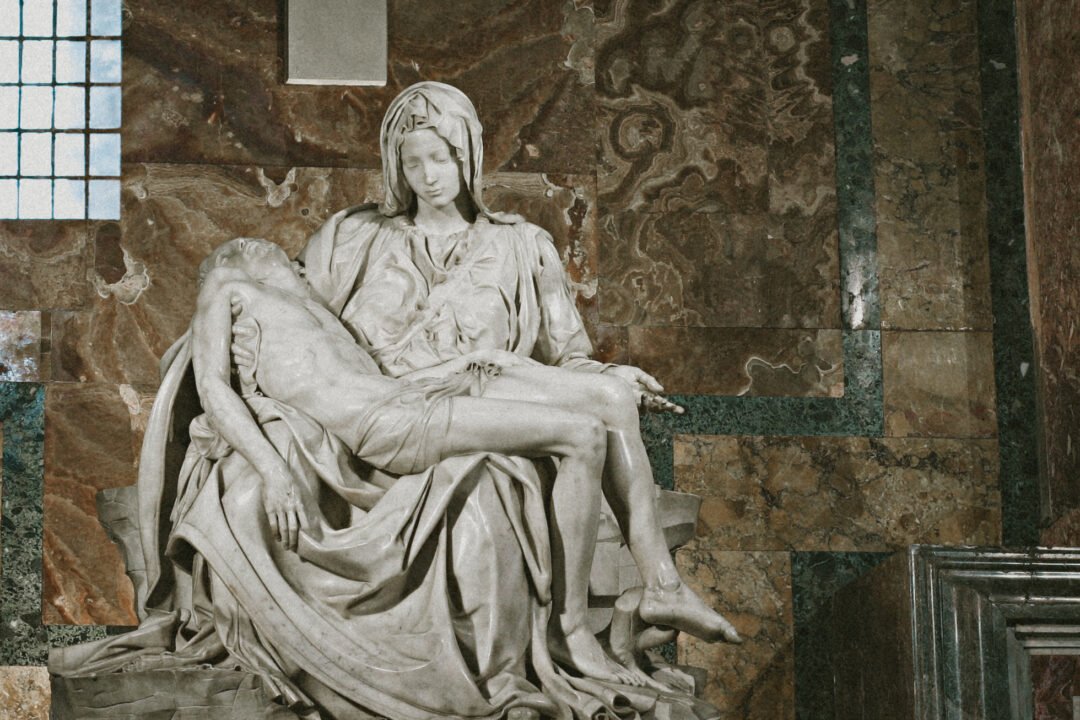The Strength in Mary’s Silence
Years ago, I found myself standing in front of her. Young yet timeless, she was awash in disheveled robes. Across her ample lap lay the body of her dead son. The sinews of his lean muscles were overshadowed by their morbid flaccidity. With head tipped and eyes closed, her right hand cradled her boy while her left rested open and upward as if to ask weakly, “Why?” This was Michelangelo’s famous Pietà located in St. Peter’s Basilica.
Sculpted from a single block of his favorite Carrara marble (Michelangelo purportedly claimed the Pietà’s marble was the most perfect block he ever worked with), the Pietà has never stopped haunting me, or comforting me. Like everyone who has laid eyes on the tragic scene, I was broken by the sheer enormity of Mary’s grief. How does one not feel a lump in their throat when beholding a mother cradling her perfect son’s bloodied, lifeless body in her lap? As I’ve grown older, however, I have been struck by an entirely different aspect of this masterpiece that I had somehow overlooked: Mary’s composure, Mary’s silent strength.
She is here. Suffering, silent, and eternally strong.
It is probably safe to say that when Mary witnessed the Passion of her son and held his broken body in her arms, she was utterly crushed. Surely, Simeon’s dark prophecy at Christ’s presentation that Mary would be pierced with a sword must have haunted her throughout her life. In fact, it is not hard to imagine Mary’s possible reactions to the full weight of the intertwined death of God and death of her child. Crying? Wailing? Breathless agony? All are conceivable and all would be justified.
But Michelangelo’s Pietà does not show us Mary broken, but Mary silent. And there is quiet strength in that silence. It is difficult for me not to look upon this statue with her eyes closed and unlined face, and hear the words embodying Mary’s reaction to the Annunciation, “She pondered [it] in her heart” (Luke 2:19). This, by no means, is meant to diminish the profound grief the Mother of God endured in her son’s unparalleled suffering. Nor is it to suggest that Mary possessed some inhuman, otherworldly detachment from the greatest horror of her life. But what if Mary saw through the suffering? What if, at her worst moment, Mary believed (as remote as they may seem) her God’s promises? What if, while heaving inwardly and blinded by tears, Mary sensed that the divine drama does not end in dark tragedy, but in incomprehensible, limitless hope?
The Mary we see in the Pietà is the epitome of a saint. We see Mary in St. Thomas More kneeling before the headsman and in St. Maximilian Kolbe singing in the starvation bunker, in St. Teresa Benedicta of the Cross in the cattle car to Auschwitz and in Blessed Miguel Pro before the firing squad. And she learned it from her son. She embraces the cross instead of rationalizing it. She surrenders to God instead of irritably effecting human plans. She loves through hate and hopes through doubt. Does she hurt? Without question. Does she worry? Of course. But she knows—even if it takes every ounce of strength to persist in the knowing—that God knows what he is doing, that God will never abandon us. In Bob Dylan’s “Shelter From the Storm,” one could sense a message of Mary’s steadfast strength and motherly intercession on our behalf.
Suddenly I turned around and she was standin’ there
With silver bracelets on her wrists and flowers in her hair
She walked up to me so gracefully and took my crown of thorns
Come in, she said
I’ll give ya shelter from the storm
It has been a long time since I stood before the Pietà at St. Peter’s Basilica. But I know Mary is there. And she is here. Suffering, silent, and eternally strong.
